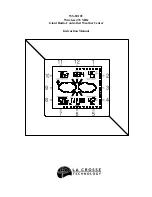
La Crosse Technology, Ltd.
Page 6
Mounting under an eave or deck rail works well.
If you choose, you can construct a small roof or box for the outdoor sensor. Be sure a box has vents.
Mount the outdoor sensor on the North side where to prevent sun from causing incorrect readings.
Mount at least 6 feet in the air for a strong RF (radio frequency) signal.
Outdoor sensors are water resistant, not waterproof.
Avoid more than one wall between the outdoor sensor and the weather station.
The maximum transmitting range in open air is over 300 feet (91 meters).
Obstacles such as walls, windows, stucco, concrete and large metal objects can reduce the range.
Do not mount near electrical wires, transmitting antennas or other items that will
interfere
with the
signal.
RF (radio frequency) signals do not travel well through moisture or dirt.
Do not mount the outdoor sensor on a metal fence. This significantly reduces the effective
range
.
MOUNT
Option 1:
Install one mounting screw (not included) into a wall.
Place the outdoor sensor onto the screw (hanging hole on the backside).
Gently pull down to lock the screw in place.
Option 2:
Insert the mounting screw through the front of the outdoor sensor and into the wall.
Tighten the screw to snug (do not over tighten).
Position Weather Station
The weather station has a wide base to sit on a desk or table.
Place within
range
of the outdoor sensor.
The maximum transmitting range in open air is 300 feet (91 meters).
Obstacles such as walls, windows, stucco, concrete and large metal objects can reduce the range.
Choose a location 6 feet or more from electronics such as cordless phones, wireless gaming
systems, televisions, microwaves, routers, baby monitors, etc., which can prevent signal reception.
Be aware of electrical wires and plumbing within a wall. This will interfere with RF (radio frequency)
signal reception.
Distance/Resistance/Interference
Distance:
The maximum transmitting range in open air is over 300 feet (91 meters) between the outdoor sensor
and the weather station. This range is in open air with ideal conditions.
Consider what is in the signal path between the weather station and the outdoor sensor.
Avoid placing electronic in the signal path between the weather station and the outdoor sensor.
Resistance:
Obstacles such as walls, windows, stucco, concrete and large metal objects can reduce the range.
When considering the distance between the outdoor sensor and the weather station (300 feet open
air), cut that distance in half for each wall, window, tree, bush or other obstruction in the signal path.
Closer is better.
Windows reflect the RF (radio frequency) signal.
Metal absorbs the signal and reduces the range.
Stucco has a metal mesh that absorbs the signal.
Do not mount the outdoor sensor on a metal fence. This significantly reduces the effective range.
Interference:
Consider items in the signal path between the outdoor sensor and the weather station.
Sometimes a simple relocation of the outdoor sensor or the weather station will correct the
interference.
Windows can reflect the radio signal.
Metal will absorb the RF (radio frequency) signal.
Stucco has a metal mesh that absorbs signal.
Avoid transmitting antennas: (ham radios, emergency dispatch centers, airports, military bases, etc.)
Electrical wires (utilities, cable, etc.)
Vegetation is full of moisture and reduces signal.




























